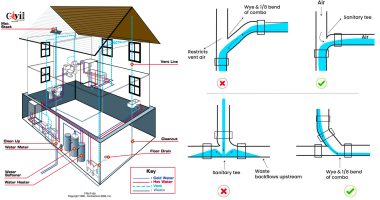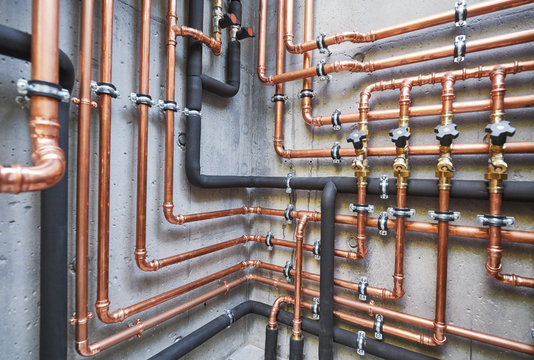The article on the next paragraphs relating to Plumbing Installation 101: All You Need to Know is really insightful. Check it out for your own benefit and decide what you think about it.

Understanding exactly how your home's pipes system works is necessary for every single property owner. From supplying clean water for drinking, food preparation, and showering to securely getting rid of wastewater, a well-maintained plumbing system is essential for your family's health and convenience. In this thorough overview, we'll explore the elaborate network that comprises your home's plumbing and offer suggestions on maintenance, upgrades, and managing typical problems.
Intro
Your home's pipes system is more than simply a network of pipelines; it's a complicated system that ensures you have accessibility to tidy water and effective wastewater elimination. Understanding its elements and exactly how they collaborate can assist you avoid pricey repairs and ensure every little thing runs efficiently.
Standard Elements of a Pipes System
Pipes and Tubing
At the heart of your pipes system are the pipelines and tubes that bring water throughout your home. These can be made from various materials such as copper, PVC, or PEX, each with its benefits in regards to toughness and cost-effectiveness.
Components: Sinks, Toilets, Showers, and so on.
Fixtures like sinks, commodes, showers, and bath tubs are where water is used in your house. Recognizing how these components link to the plumbing system helps in diagnosing troubles and intending upgrades.
Valves and Shut-off Points
Shutoffs regulate the flow of water in your plumbing system. Shut-off shutoffs are vital during emergency situations or when you need to make fixings, permitting you to isolate parts of the system without interfering with water flow to the whole home.
Supply Of Water System
Main Water Line
The major water line links your home to the community water system or a personal well. It's where water enters your home and is distributed to numerous components.
Water Meter and Stress Regulator
The water meter actions your water use, while a pressure regulatory authority guarantees that water flows at a secure pressure throughout your home's pipes system, avoiding damages to pipes and components.
Cold Water vs. Warm water Lines
Understanding the difference between cold water lines, which provide water directly from the major, and warm water lines, which lug warmed water from the hot water heater, assists in troubleshooting and preparing for upgrades.
Drain System
Drain Pipes and Traps
Drain pipelines bring wastewater away from sinks, showers, and toilets to the sewage system or septic system. Catches protect against drain gases from entering your home and additionally trap debris that can trigger blockages.
Air flow Pipes
Air flow pipes allow air right into the drain system, preventing suction that might slow water drainage and trigger traps to empty. Correct ventilation is crucial for maintaining the integrity of your pipes system.
Importance of Proper Water Drainage
Ensuring proper drain prevents backups and water damage. Consistently cleaning drains and maintaining catches can protect against costly repair services and expand the life of your plumbing system.
Water Heating Unit
Kinds Of Hot Water Heater
Water heaters can be tankless or traditional tank-style. Tankless heaters warmth water as needed, while containers store heated water for immediate use.
How Water Heaters Attach to the Pipes System
Recognizing how water heaters attach to both the cold water supply and warm water distribution lines assists in identifying concerns like insufficient hot water or leaks.
Upkeep Tips for Water Heaters
Consistently purging your hot water heater to eliminate debris, inspecting the temperature level setups, and inspecting for leaks can extend its life expectancy and enhance power performance.
Common Plumbing Issues
Leaks and Their Causes
Leakages can happen because of aging pipelines, loose installations, or high water stress. Resolving leakages without delay prevents water damage and mold growth.
Clogs and Blockages
Clogs in drains and bathrooms are typically caused by purging non-flushable things or an accumulation of oil and hair. Utilizing drainpipe displays and bearing in mind what decreases your drains can stop clogs.
Signs of Plumbing Issues to Look For
Low tide stress, slow-moving drains pipes, foul odors, or abnormally high water bills are signs of potential plumbing issues that must be resolved promptly.
Plumbing Upkeep Tips
Normal Examinations and Checks
Set up yearly pipes examinations to capture problems early. Look for signs of leaks, rust, or mineral accumulation in faucets and showerheads.
DIY Maintenance Tasks
Easy tasks like cleaning tap aerators, looking for commode leakages making use of color tablet computers, or shielding revealed pipelines in cool environments can protect against significant pipes concerns.
When to Call a Specialist Plumbing Professional
Know when a plumbing issue calls for expert competence. Attempting intricate repair services without appropriate knowledge can bring about more damages and higher fixing costs.
Updating Your Plumbing System
Factors for Upgrading
Upgrading to water-efficient components or replacing old pipelines can improve water high quality, reduce water expenses, and raise the value of your home.
Modern Pipes Technologies and Their Benefits
Check out technologies like smart leakage detectors, water-saving commodes, and energy-efficient water heaters that can conserve money and decrease ecological impact.
Expense Factors To Consider and ROI
Calculate the in advance expenses versus lasting financial savings when considering plumbing upgrades. Several upgrades pay for themselves with lowered utility expenses and less repairs.
Environmental Effect and Preservation
Water-Saving Fixtures and Home Appliances
Setting up low-flow taps, showerheads, and bathrooms can dramatically minimize water use without compromising efficiency.
Tips for Lowering Water Use
Easy routines like fixing leakages without delay, taking shorter showers, and running complete tons of washing and recipes can preserve water and lower your energy costs.
Eco-Friendly Pipes Options
Take into consideration sustainable plumbing products like bamboo for floor covering, which is durable and environmentally friendly, or recycled glass for counter tops.
Emergency situation Preparedness
Steps to Take Throughout a Plumbing Emergency
Know where your shut-off valves are located and how to shut off the water system in case of a ruptured pipe or significant leakage.
Importance of Having Emergency Contacts Handy
Keep get in touch with details for regional plumbers or emergency situation solutions readily available for fast action during a plumbing situation.
Do It Yourself Emergency Fixes (When Applicable).
Short-term repairs like utilizing air duct tape to spot a dripping pipeline or positioning a pail under a leaking faucet can lessen damages up until an expert plumbing technician shows up.
Conclusion.
Recognizing the makeup of your home's pipes system encourages you to keep it successfully, conserving time and money on repairs. By following routine upkeep routines and remaining notified about contemporary plumbing modern technologies, you can guarantee your plumbing system operates effectively for many years to find.
Exploring Your Homes Plumbing Anatomy
Water Supply System
- Main Water Line: This is where water enters your home from the municipal supply or a private well.
- Water Meter: Typically located near where the main water line enters the property, it measures the amount of water used.
- Shutoff Valve: It s crucial to know where this is in case of emergencies. It allows you to turn off the water supply to the entire house.
- Pipes and Fittings: These distribute water throughout your home. Materials can include copper, PVC, or PEX.
Drain-Waste-Vent (DWV) System
- Drains: Located in sinks, showers, and tubs, these carry wastewater away.
- Traps: U-shaped pipes under sinks that hold standing water, blocking sewer gases from entering the home.
- Vents: Pipes that lead from the DWV system to the outside, preventing vacuum formation and allowing gases to escape.
- Sewer Line: Carries all wastewater from the home to the municipal sewer system or a septic tank.
Fixtures and Appliances
- Sinks, Toilets, and Showers
- Dishwashers and Washing Machines
- Water Heaters
Maintenance Tips
- Regularly check for leaks in exposed pipes and around fixtures.
- Inspect the water heater annually for signs of wear.
- Clean drains and traps to prevent clogs and odors.
- Know how to shut off water to individual fixtures.
When to Call a Professional
- Major leaks or burst pipes
- Installation of new pipes or fixtures
- Septic tank issues
- Remodeling projects that involve plumbing changes
Conclusion
Understanding the anatomy of your home's plumbing is key to maintaining a functional and efficient system. Regular checks and knowing when to call in the experts can save you time, money, and stress.
https://www.mavyn.com/blog/exploring-your-homes-plumbing-anatomy

Do you appreciate reading about Exploring Your Homes Plumbing Anatomy? Leave a review down the page. We will be happy to find out your insights about this page. We are looking forward to see you back again in the near future. So long as you enjoyed reading our blog post kindly do not forget to share it. I enjoy your readership.
Schedule Now!
Comments on “A Detailed Look at Your House's Plumbing System Anatomy”